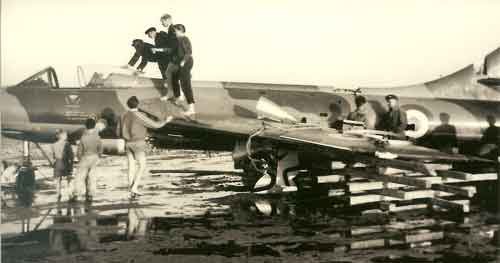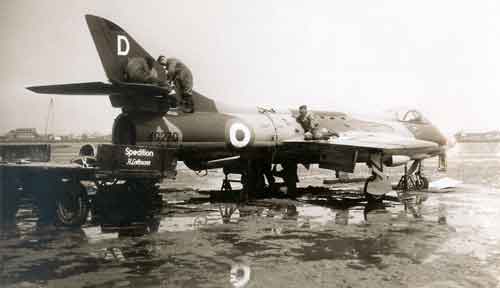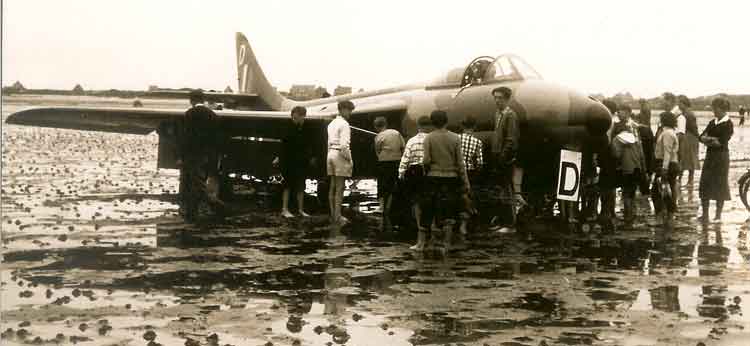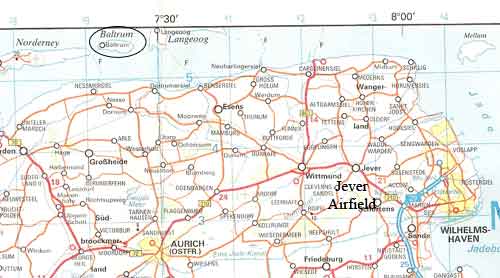 2ND TACTICAL AIR FORCE FLIGHT COMMENT MAGAZINE
2ND TACTICAL AIR FORCE FLIGHT COMMENT MAGAZINE
 May 1957 issue.
May 1957 issue.
 Major Accident, Hunter F.6 XG 270 31st May, 1957
Major Accident, Hunter F.6 XG 270 31st May, 1957

On entering cloud
at about 2000 ft., there was a loud explosion in the engine bay, followed by a total loss of power and automatic reversion to manual, plus severe vibration. The
pilot straightened out and set up a gliding speed, breaking cloud over the coast heading towards the island of Baltrum. A distress call was made but apart from a loud background noise there was no response. The pilot did not consider that he could reach land so he decided to eject and pulled the canopy ejection handle. The canopy did not come off. He then decided not to eject through the canopy which he thought may have become loose, but to attempt to land in shallow water or on the beach. He pulled the undercarriage emergency air, but only the starboard undercarriage and nose wheel locked down. Flaps were blown down and he forced landed on the beach of the island of Baltrum. When the port wing tip dropped it slewed the aircraft round to port about 100° There was no fire.


Six Horsepower
Hunter F.6

The unfortunate
F.6 XG270 D of
4 Sqn at Baltrum on 31 May 1957 (top) showing the skilful support of the port wing constructed by a local builder, and (lower) , that despite the valiant efforts of the builder and the rescue team, including six willing horses, the sea claimed one very valuable
Hunter! (Thanks to
Gunter Kipp and
Roger Lindsay's great book "RAF
Hunters in Germany" and the original photographers top G. Hindersmann and bottom
Ray Chapman). (Not in Flight Comment Report).

 Hunter F.6 XG270 D
Hunter F.6 XG270 D of
4 Sqn being dismantled after an emergency landing on the mud flats south of the North Sea island of Baltrum on 31 May 1957, caused by an engine failure. (See map below). Its pilot
Flt. Sgt. T. E. (Ginger) Ratcliffe, survived unhurt, only to be killed while flying a
4 Sqn Hunter FR.10 on 24 January 1967.
XG270 had to be written off as it was swamped by the in-coming tide before it could be moved to higher ground which was unfortunate because it had only been delivered to the
squadron on 28 February 1957 and was virtually brand new with few airframe hours. (Thanks to
Gunter Kipp and
Roger Lindsay's great book "RAF
Hunters in Germany" and the original photographer J Harms). (Not in Flight Comment Report).


Map showing Island of Baltrum in relation to Jever Airfield. (Not in Flight Comment Report).
COMMENT:

The primary cause of this accident was failure of the engine compressor of the Avon 203. After being faced with an engine failure in cloud at only 2000 ft., plus the other failures, the
pilot did extremely well to bring the
aircraft down causing very little further damage. Unfortunately sea water contamination meant re-categorisation to
Cat. 5 components.

The failures and
answers, as far as possible anyway, are as follows:-

(a) Engine failure - compressor blade failure. The manufacturers are investigating this and other similar failures in the Avon. 203's.

(b) Radio failure - no defect found. It is possible that the explosion may have effected the bonding and thus caused interference on the
R/T.

(c) Failure of hood jettison - no defect found. The handle was probably not pulled hard enough. The canopy jettison lever requires a pull of 65 lbs. to operate the mechanism successfully as opposed to the
Mk. 4 which only requires 25 lbs. However, the correct procedure for ejecting from the
Mk. 6 is to lower the
G.G.S., withdraw the feet (place them in the foot rests for the Mark 2 H seat), head back on the rest, and pull the blind handle. The canopy is jettisoned automatically by gas pressure as part of the ejection sequence. The abandoning drill as detailed on the back cover of Pilots' Notes is being amended.

(d) Failure of port main wheel to lock down - no defect found. The handle was probably not pulled out far enough. In order to operate the emergency lowering, it is essential that the handle be pulled right out of its guide otherwise the valve, which is spring loaded, may close again when the handle is released. This appears to have occurred in this instance.

[Click here to see the report of this incident in the F540 Monthly Operations Record for
 May 19579 for No 4 Squadron.]
May 19579 for No 4 Squadron.]